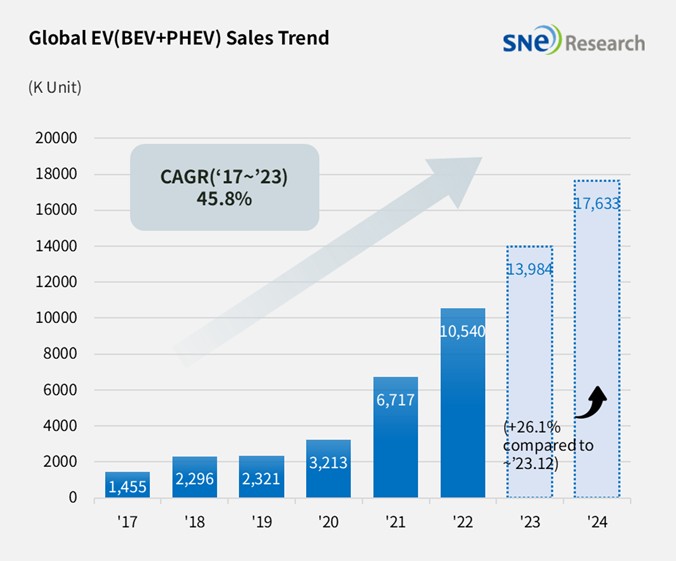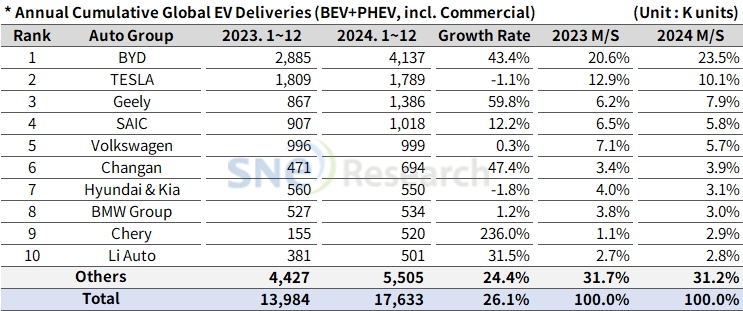From Jan to Dec 2024, Global[1] Electric Vehicle Deliveries[2] Recorded Approx. 17.63 Mil Units, a 26.1% YoY Growth
- In 2024, BYD ranked No. 1 in the ranking of global EV sales
From Jan to December 2024, the number of electric vehicles registered in
countries around the world was approximately 17.63 million units, approx. 26.1% YoY increase.

(Source: Global EV and Battery Monthly Tracker – Jan 2025, SNE Research)
If we look at the global EV sales by major OEMs from Jan to Dec 2024, BYD ranked No. 1 in the world by selling 4.137 million units and posting a 43.4% YoY growth. BYD enjoyed favorable sales of Song(宋), Seagull (海鸥), and Qin(秦) in the Chinese domestic market, and it also expanded sales of Atto 3 and 4 Dolphin (海豚) in the non-China market, rapidly expanding its market share. BYD does not only established a variety of BEV and PHEV line-ups, but it also launched sub-brands such as Denza(腾势), Yangwang(仰望), and FangCheong Bao(方程豹) to diversify its vehicle line-ups at different levels. In addition, as BYD has been expanding its presence in Europe, Southeast Asia, and South America in an effort to respond flexibility to tariff barriers, it has been successfully maintaining such a high growth in the global market.
Tesla, ranked 2nd on the list, saw a decrease in sales of Model 3 and Y, which account for approx. 95% of Tesla’s entire sales, posting a 1.1% YoY degrowth. Particularly in Europe and North America, where EV demand has been sluggish, Tesla saw a huge drop in sales by 10%. Tesla currently aims to produce a new model at entry-level in the first half of 2025 and also improve the FSD technology this year, leading to an expectation for increased sales in 2025.
The 3rd place was captured by Geely Group which sold more than 130k units of light EV Panda (熊猫) Mini in the Chinese domestic market. ZEEKR (极氪), a premium brand owned by Geely Group, sold around 110k units of ZEEKR 001. Combining all of these, Geely Group posted a high growth of 59.8%. Like BYD, Geely Group has been focusing on midsize/premium vehicle markets through diversification of brands such as Galaxy (银河) and LYNK & CO (领克). As the Group has been expanding its presence in Europe and Southeast Asia, it is expected to compete with BYD in emerging markets.
Other than these, the Chinese OEMs’ growth is quite noticeable. The Chinese EV makers, which maintained a similar level of growth to the previous due to a sluggish growth in Europe and North America in 2024, have been expanding their market shares based on strong sales in the Chinese domestic market. Chery, which boasted the highest growth among top 10, successfully increased its brand awareness by launching vehicles with various powertrains. Li Auto, ranked 10th, has been increasing its market share by transitioning from EREV to BEV.

(Source: Global EV and Battery Monthly Tracker – Jan 2025, SNE Research)
Hyundai Motor Group sold approx. 550k units of electric vehicles, recording a 1.8% YoY degrowth. Although the Group’s main models – IONIQ 5, EV6, and NIRO – sold less than the same period of last year, the global sales of EV3 and EV9 are increasing. Especially in the North American market, Hyundai Motor Group delivered more electric vehicles than Stellantis, Ford, and GM, boasting a strong growth momentum. Hyundai Motor Group commenced full-scale operation of HMGMA, which enabled it to produce at least 5 different types of electric vehicles on the US soil. This makes it quality for tax credits of max. US$ 7,500 under the US IRA. However, the Trump administration publicly announced that it would revoke the IRA and reduce tax credits accordingly, the Group is expected to respond to changes in business environment and relevant policies so that it can solidify its presence in the US market.

(Source: Global EV and Battery Monthly Tracker – Jan 2025, SNE Research)
In Europe, the EV sales experienced a 1.0% YoY degrowth in 2024, meaning that the European market has reached a plateau. On the other hand, with sales of HEV increasing by 22.1%, there seems to be a tendency in Europe to choose HEV rather than BEV. This was caused by a combination of different factors including shortage of EV charging infrastructure and weakened competitiveness in vehicle price.
In the US, there are challenges to tackle; revocation of the EV mandate and high tariffs. The US President Donald Trump announced to implement a 25% additional tariff on electric vehicles imported from Mexico and Canada and a 10% additional tariff on those imported from China, which prevents the Chinese electric vehicles from entering the US market by taking a detour. The approval of full self-driving (FSD) may act as a factor to increase the penetration rate of electric vehicles. commercialization of self-driving technology may lead to expansion of demand for electric vehicles, possibly reignite the growth of EV market in the US.
In Asia (excl. China) and other regions, the EV markets have been rapidly expanding and recording a two-digit growth despite the so-called chasm phase. In particular, the Chinese EV makers are dominating the late-comer markets, accelerating the distribution rate of electric vehicles in emerging countries.
China, accounting for 59.5% of the entire EV market in the world, remained No. 1 on the list. Recording a 39.7% YoY growth, China has been leading the expansion of EV market, supported by full government support and strong demand from the domestic market. However, as the US and Europe are trying to prevent the Chinese EV makers from entering their markets by imposing additional tariffs on the Chinese electric vehicles, there are possibilities that China would revise its export-driven growth strategy.
Those policy changes in Europe and the US are highly likely to lead a continuous decline in demand for electric vehicles till 2025. To be specific, the US and Europe are currently reshuffling the market structure based on regulatory changes and protectionism. It is time for EV makers to come up with appropriate response measures to cope with these changes. After 2026, with the launch of new models and mass production of battery, a new growth momentum is expected to form. In this regard, electric vehicle makers are facing an important turning point now to find diverse response measures such as securing cost competitiveness, strengthening hybrid strategies, and adopting autonomous driving technology.
[2] Based on electric vehicles (BEV+PHEV) delivered to customers or registered during the relevant period

